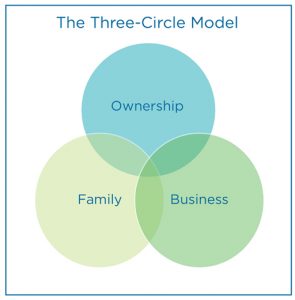Conflict is an inherent part of human interaction, arising whenever there is a divergence of opinion or interest on a concrete issue.
In the context of family businesses, the most successful organizations anticipate and manage conflict before it arises. These companies recognize conflict as a natural occurrence: if it hasn’t cropped up yet, it’s only a matter of time.
The source of conflict
Conflict in family firms typically arises from the intersection of family, ownership and business, the three core systems defined by Prof. John Davis.

Source: Renato & Davis, 1982.
In a technical note on conflict in family business, co-authored with my colleague Prof. Salvador Rus, we observed that conflicts often emerge in one or more of these spheres.
Underlying motives vary, including emotional bonds, rights and obligations, differing moral perspectives, individual interests and opposing views on the company’s future growth.
In all cases, a common thread emerges: the interplay between the role an individual holds within the family business and the motivations that influence their perspectives.
Everyone who plays a role in the three-dimensional realm of family business views the company from their specific vantage point. From this position, their expectations and views on the company’s present and future are formed, as well as the company’s expectations of them.
Expectations, rights and responsibilities
Referring back to Davis’s three-circle framework, individual expectations will differ based on the person’s role–whether they are shareholders, executives, board members or family members with no direct stake or leadership function in the business.
The first step in addressing conflict is to understand the actor’s position within this framework. By doing so, we can identify where expectations may diverge from reality, which is often the source of conflict.
Family business roles frequently create discrepancies in expectations, rights and responsibilities. Some common sources of conflict are as follows:
Role conflicts, when roles overlap or are poorly defined within the family-business-ownership framework.
Affective conflicts, driven by emotional ties, familial relationships and personal dynamics.
Strategic and process conflicts, related to differences in strategic vision, decision-making approaches or management methods.
Each of these conflicts can directly impact the family unit and, in turn, influence the overall strength of corporate governance.
Converting conflict into opportunity
Leaders of family businesses have a unique opportunity to turn conflict into an opportunity for growth. When approached with a transformational mindset, conflict is not just an obstacle but a potential driver of change.
When managed effectively, conflict can foster creativity, innovation and even strengthen family unity. However, these benefits are not a given: they require a solid strategy and the necessary resources.
Family businesses must create a culture of open communication and collaboration, providing a platform for negotiation and dialogue. Establishing clear guidelines for conflict resolution before issues arise is essential, whether they are driven by emotional or rational matters.
Emotions should be managed in a way that benefits the individual, the family and the business. It’s essential to provide methodologies and training for everyone involved, and to distinguish between data-based facts and personal opinions or impressions.
Above all, the goal should be to reason through conflict, rather than simply “being right.”
Homepage image: Headway on Unsplash

